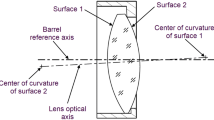Abstract
This research increases the ability and value of a traditional vertical lathe and applies to manufacture a precise lens cell for the optical industry. The optical performance is limited by the residual centration error and position accuracy of conventional assembly methods. Recently, the development of a poker-chip assembly system with high-precision lens barrels has overcome these limitations and provided a solution for ultra-high-performance optical systems. To develop a high-precision lens cell by using poker-chip assembly, an alignment turning system (ATS), is developed based on a vertical lathe and equipped with tactile and optical measurement modules. Inside the ATS, the building-in the vibration/temperature monitoring sensors, which help to self-monitoring and network communication with the intelligent manufacturing techniques, to understand and master the reliability and efficiency of ATS. This system can manufacture precise lens cells, applied for optical metrology, high numerical aperture objective lenses, and lithography projection lenses. This paper describes the design and development of the ATS and its capabilities. The ATS is composed of measurement, alignment, and turning modules. After the ATS completes the measurement, alignment, and turning processes, the centration error of a lens cell, which is 200 mm in diameter, can be controlled to within 10 arcsec. Here, a lens cell with three subcells was assembled through the poker-chip method; each subcell was measured and then it underwent alignment and turning processes. The lens assembly test was performed five times by three technicians, and the average transmission centration error of the assembly lens was 12.45 arcsec. The results demonstrate that the ATS can achieve considerable assembly efficiency for high-precision optical systems.
Similar content being viewed by others
References
Lamontagne F et al (2015) Lens auto-centering. Proc SPIE 962619:9626
Lamontagne F et al (2016) Disruptive advancement in precision lens mounting. Proc SPIE 95820D:9582
Langehanenberg P, Heinisch J, Buß C, Wilde C (2014) High-precision mounted Lens production. Opt Photonik 9:41–45
Yoder P (2002) Mounting Optics in Optical Instruments, SPIE optical engineering press. Bellingham, Washington
Peng WJ et al (2017) Design, tolerance analysis, fabrication, and testing of a 6-in. Dual-wavelength transmission sphere for a Fizeau interferometer. J Opt Eng 119:235–246
Souchon A (2015) Enabling micron level mounting accuracy. Melles Griot Exact Placement™ Lens Assembly Technology, Melles Groit, Rochester, NY
Ho CF et al (2012) Study on measurement of 160 mm convex hyperbolic mirror for Cassegrain reflecting system. Proc SPIE 84860Q:8486
Huang CY et al (2017) The development of alignment turning system for precision lens cells. Proc SPIE 103710E:10371
Hsu WY, Lee CS, Chen PJ, Chen NT, Chen FZ, Yu ZR, Kuo CH, Hwang CH (2009) Development of the fast astigmatic auto-focus microscope system. Meas Sci Technol 20:045902
Huang CY et al (2016) Development of precision angle measurement system. Proc IEEE Int Instrum Meas Technol Conf. https://doi.org/10.1109/I2MTC.2016.7520530
Beier M et al (2012) Lens centering of aspheres for high-quality optics. Adv Opt Technol 1:441–446
Acknowledgments
This material was based on work supported by the Ministry of Science and Technology of Taiwan, R.O.C. under Grant No. MOST 106-2218-E-007-023. The authors and researchers wish to thank MAX SEE INDUSTRY CO., LTD. for constructing the turning module and the control interface of the ATS.
Author information
Authors and Affiliations
Corresponding author
Rights and permissions
About this article
Cite this article
Huang, CY., Ho, CF., Wang, JH. et al. Alignment turning system for precision lens cells. Int J Adv Manuf Technol 100, 1383–1392 (2019). https://doi.org/10.1007/s00170-018-2699-x
Received:
Accepted:
Published:
Issue Date:
DOI: https://doi.org/10.1007/s00170-018-2699-x




